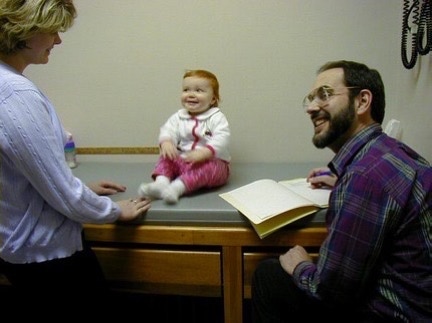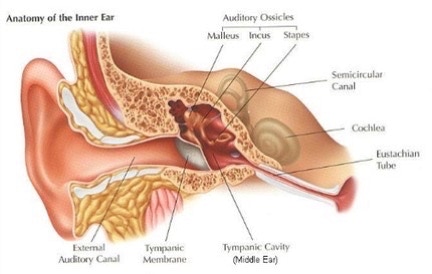Ear Infections in Children
Otitis media, an infection in the "middle ear", is one of the most common infections in children. The middle ear is the space behind the eardrum normally filled with air which allows the eardrum to vibrate and transmit sounds to your brain via the cochlea. Air normally gets into the middle ear through the eustachian tube, which connects to the throat. When you feel your ears "pop" it is from air moving through the eustachian tube either into or out of your middle ear.
Otitis media is most commonly caused by pneumococcus germs that normally live in the nose and throat. If the middle ear stays dry, germs cannot live there. Sometimes fluid builds up allowing germs to grow in the middle ear, causing otitis media. This often happens after a virus cold, but may also result from allergies, or irritants (like cigarette smoke) which cause swelling and blockage of the eustachian tube. In fact, children exposed to cigarette smoke have 4 times as many ear infections as non-exposed children.
Another risk factor for ear infections is being in day care. This exposes children to far more virus infections that could cause the eustachian tubes to become blocked. Being in day care also allows children to pass around several other types of bacteria that can cause ear infections, as well as passing bacteria that have become resistant to most antibiotics.
Antibiotic resistance is making the treatment of ear infections more difficult. Fortunately, 80% of ear infections will clear up without using antibiotics.New guidelines from the CDC(Centers for Disease Control) warn doctors not to treat otitis media with the expensive newer broad-spectrum antibiotics, but to use amoxicillin as the first line drug. Many reasons are given for this choice, including the effectiveness, safety and low cost of amoxicillin, as well as the important effect of reducing antibiotic resistance.
Amoxicillin is the first-line drug for ear infections.
When should otitis media be treated with antibiotics? If the child is not acutely ill, it is safe to treat with numbing ear drops to stop the pain, and either observe for a few days (since 80% will go away without using drugs) or else use a 10-day course of amoxicillin. In older children, a shorter course (5 days) may be effective, but more studies are needed to prove this. If the child was treated with amoxicillin within the last month, a second choice drug should be used.
Most cases of otitis media are actually not true infections but merely fluid build-up inside the middle ear. These are known asOtitis Media with Effusion (OME).The CDC is also warning doctors NOT to treat OME with antibiotics, which of course will not help the problem at all, but will contribute to bacterial resistance, and may harm the patient if side effects occur. OME usually just requires time to clear up, but can also be helped by popping your ears, to allow air to enter the middle ear space. Doctors sometimes try using decongestant medicines, which may help to relieve cold or allergy symptoms, but otherwise have not been shown to be very effective in treating OME.
When do we recommend putting in EAR TUBES?If a child has more than 5-6 separate ear infections in a year, we do recommend putting a tiny plastic or steel tube into the eardrum. This allows air to enter the middle ear space and keeps it dry. Ear tubes last about one to four years, and fall out by themselves, usually without your knowing it. It requires surgery (outpatient) and anesthesia, so putting in tubes is the last resort for recurrent ear infections. Ear tubes may also be considered if OME is lasting for over 6 months, and is interfering with a child’s ability to hear.
Current strategies for preventing ear infections include: avoiding day care centers (if possible), keeping the home smoke-free, providing good nutrition, teaching your child good hand-washing practices, and keeping immunizations up-to-date, including the new pneumococcal vaccine.
Adults smoking in the home is a major risk factor for children getting ear infections.
Exclusive breastfeeding during the first 6 months also reduces the chances of getting ear infections. Antibodies in the breastmilk have a protective effect. Also bottle-fed babies tend to have more chance of getting milk into the eustachian tubes.
A study just published showed a 10% increase in ear infections in babies who use pacifiers. I'm not sure if this is due to altered pressure in the eustachian tubes, or may have something to do with bacteria on the pacifier (especially in the daycare setting where resistant pneumococcus is found).
A previously used strategy for preventing ear infectionsused to beputting kids on preventive antibiotics. This treatment is no longer used, because of the serious risk of antibiotic resistance.



